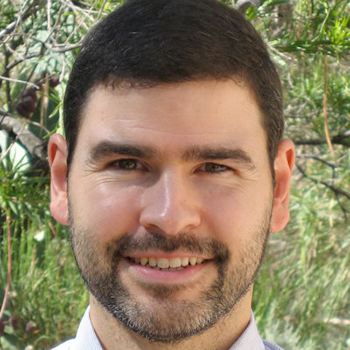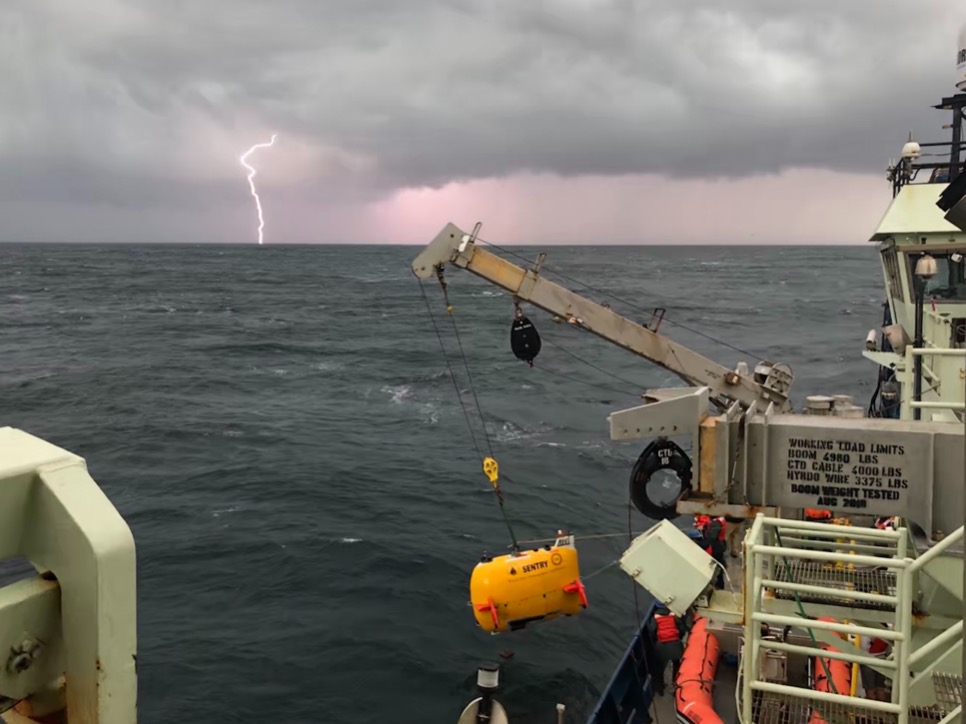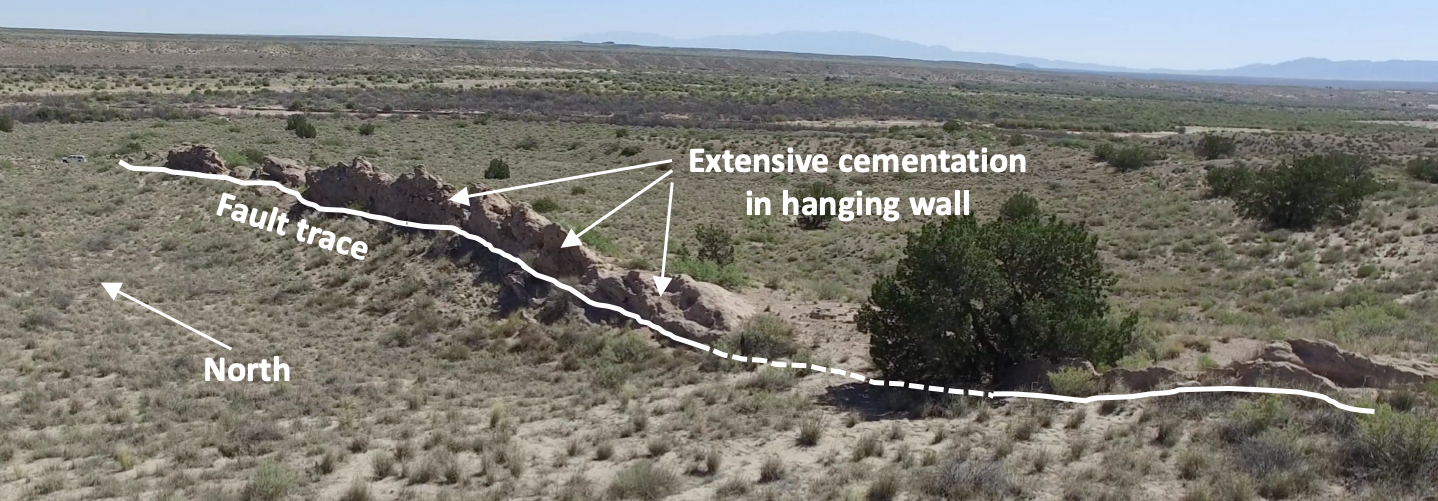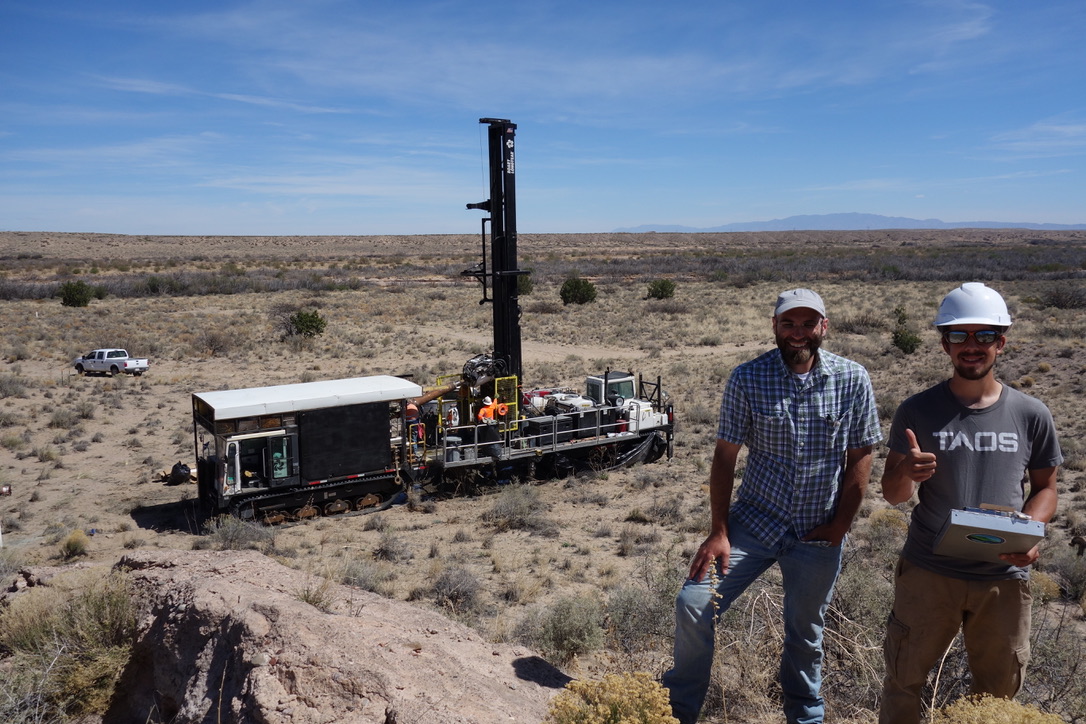
Glenn Spinelli, PhD
Professor
Earth & Environmental Sciences
- [email protected]
- 575 - 835 - 6512
- MSEC 360
Research Interests
Marine Hydrogeology
In ocean crust, fluid flow between the basaltic basement aquifer and the overlying ocean is an important control on heat transport, solute transport, and alteration of the crust. As sediments gradually accumulate on oceanic crust, they change the nature of fluid circulation within the basement aquifer. My interests in marine hydrogeology include fluid and heat circulation patterns in ocean crust, permeability evolution of ocean crust, and fluid and heat flow through seafloor sediments. I have studied fluid and heat flow in diverse settings, including the flanks of mid-ocean ridges, subduction zones (e.g., Costa Rica, Nankai Trough, Cascadia, and southern Chile), and estuaries.
Follow this link for information on an ongoing project examining hydrothermal circulation in oceanic crust approaching the Cascadia subduction zone: CHINOoK (Cascadia Hydrothermal circulation IN Ocean (K)rust).
Below: Photo of AUV Sentry being deployed to map a seep site offshore Oregon.
As ocean crust subducts, fluid circulation within it is an important control on subduction zone temperature. With current and former students, I have studied the evolution of hydrothermal circulation in subducting crust. In these studies, we examined some general aspects of fluid and heat circulation in subducting crust — for example, how far into a subduction zone can fluid circulation in the ocean crust aquifer persist, and what are the thermal consequences of that circulation? We have examined fluid and heat circulation in the Nankai Trough (southern Japan), Cascadia, southern Chile, Mexico, and northern Japan subduction zones. We found that the thermal effects of fluid circulation in subducting crust may extend the seismogenic portion of the plate boundary fault closer to the shoreline and populated areas than previously estimated.
I am also interested in how water derived from mineral dehydration reactions affects the fluid pressure distribution in subduction zones. In the subduction zone offshore Costa Rica, I examined how the release of water bound in minerals may affect the distribution of fluid overpressures (and therefore effective stress) on the plate boundary fault. That study focused on dehydration reactions in sediment at fairly low temperatures (<150 ˚C). In ongoing projects, I am examining how the release of water from the basement rocks of oceanic crust at higher temperatures may affect the distribution of excess fluid pressures in subduction zones, and how fluid sources from the subducting slab link with mantle wedge alteration and melting. This has implications for understanding the overall “plumbing system” of subduction zones.
Fault zone permeability
In collaboration with geologists and hydrogeologists in our department, I am working on a geological, geophysical, and hydrological study of field-scale fault-zone cementation and permeability. Geologic faults usually make the news only when they have produced damaging earthquakes. However, faults also quietly have an important impact on society that most people never think about – they control the flow of groundwater and petroleum in aquifers and oil fields. In fact, a fault acting as a barrier for fluids can make the difference between a productive water or oil well and a terrible one. This is true for the Rio Grande aquifer system, in which groundwater levels can vary by hundreds of feet as fault zones are crossed. Through this study, we will address the difficult question of the role that natural cements plays in controlling the ease with which fluids pass through faults.
Below: Photo of a strongly-cemented portion of the Loma Blanca Fault.
The cements are composed of minerals precipitated from groundwater over thousands of years or more. As the minerals precipitate they fill pores in the rock, clogging them, and making it difficult for fluids to flow. However, determining the distribution of fault-zone cements is difficult. As a result, fault-zone cementation is typically not accounted for in estimates of the impact of faults on fluid flow. In our study, we are taking advantage of unique electrical properties of natural cements to map their 3-D distribution in an exceptionally well-exposed fault zone a few miles north of Socorro, NM. Then, we will directly measure the impact of the cements on groundwater flow by drawing water from wells adjacent to the fault.
Below: Coring and well-installation operations at the Loma Blanca Fault.

Sedimentology/sediment physical properties
Variations in sediment type and porosity can lead to large differences in sediment permeability. My previous sediment oriented studies range from determining sedimentation patterns on the northern California margin from reflection seismic data to laboratory consolidation and permeability testing of sediments from San Francisco Bay, the Juan de Fuca Ridge flank, and the Congo Fan.
Some of my work in this area examines the thermal, diagenetic, and consolidation history of sediment approaching the Nankai Trough subduction zone off Japan. I have examined silica cementation of hemipelagic sediment on the Nankai margin. I sailed on an IODP expedition to examine cementation/deformation of sediment approaching and entering the Nankai Trough subduction zone. I am also characterizing the thermal state of the Nankai Trough subduction zone.
Publications
* indicates student author, Spinelli primary advisor
Lee, M. K., S.M. Carbotte, S. Han, B. Shuck, P. Gurun, B. Boston, M.R. Nedimovic, H. Tobin, *B. Norvell, and G. Spinelli (2025). Anomalous sediment consolidation and alteration from buried incoming plate seamounts along the Cascadia Margin. Geochemistry, Geophysics, Geosystems, 26, e2024GC011949, https://doi.org/10.1029/2024GC011949.
*Norvell, B., *T. Kyritz, G.A. Spinelli, R.N. Harris, K. Dickerson, A.M. Tréhu, S. Carbotte, S. Han, B. Boston, M. Lee, and the CHINOoK project science party, 2023. Thermally significant fluid seepage through thick sediment on the Juan de Fuca plate entering the Cascadia subduction zone, Geochemistry, Geophysics, Geosystems, 24, e2023GC010868, https://doi.org/10.1029/2023GC010868.
Spinelli, G.A., A. Clark, M. Clark, S. Edel, S. Farrar, J. Fastle, C. Greigo, et al., 2022. Magnetic field intensity evidence for a buried basalt body in Socorro Canyon. In Socorro Region III, New Mexico Geological Society 72nd Annual Fall Field Conference Guidebook, ed. D.J. Koning, K.J. Hobbs, F.M. Phillips, W.J. Nelson, S.M. Cather, A.C. Jakle, and B. Van Der Werff, 112–113. https://doi.org/10.56577/FFC-72.
*Barnes, H., *J.R. Hinojosa, G.A. Spinelli, P.S. Mozley, D. Koning, T.G. Sproule, and J.L. Wilson, 2021. Detecting fault zone characteristics and paleo-valley incision using electrical resistivity: Loma Blanca Fault, New Mexico, Geophysics, https://doi.org/10.1190/geo2020-0375.1.
Harris, R.N., G.A. Spinelli, M. Hutnak, 2020. Heat flow evidence for hydrothermal circulation in oceanic crust offshore Grays Harbor, Washington, Geochemistry, Geophysics, Geosystems, https://doi.org/10.1029/2019GC008879.
*Sproule, T.G., G.A. Spinelli, J.L. Wilson, M.D. Fort, P.S. Mozley, and J. Ciarico, 2020. The effects of fault-zone cementation on groundwater flow at the field scale, Groundwater, https://doi.org/10.1111/gwat.13062.
*Lucero, A.C., G.A. Spinelli, J. He, 2019. The Thermal Effects of Plate-Bending-Related Thickening of the Oceanic Crustal Aquifer in the Nankai Trough and Japan Trench Subduction Zones, Journal of Geophysical Research, doi:10.1029/2018JB016556. Abstract.
Huepers, A., L.N. Warr, G. Grathoff, K. Wemmer, G. Spinelli, and M. Underwood, 2019. Spatio-temporal characterization of smectite-to-illite diagenesis in the Nankai Trough accretionary prism revealed by samples from 3 km below seafloor, Geochemistry, Geophysics, Geosystems. doi:10.1029/2018GC008015. Abstract.
Spinelli, G., I. Wada, K. Wang, J. He, R. Harris, and M. Underwood, in 2018. Diagenetic, metamorphic, and hydrogeologic consequences of hydrothermal circulation in subducting crust, Geosphere. doi: 10.1130/GES01653.1. Abstract.
Harris, R.N., G.A. Spinelli, and A.T. Fisher, 2017. Hydrothermal circulation and the thermal structure of shallow subduction zones, Geosphere, doi:10.1130/GES01498.1. Abstract.
*Perry, M., G.A. Spinelli, I. Wada, and J. He, 2016. Modeled temperatures and fluid source distribution for the Mexican subduction zone: effects of hydrothermal circulation and implications for plate boundary seismic processes, Geochemistry, Geophysics, Geosystems, doi:10.1002/2015GC006148. Abstract.
Spinelli, G.A., I. Wada, J. He, and *M. Perry, 2016. The thermal effect of fluid circulation in the subducting crust on slab melting in the Chile subduction zone, Earth and Planetary Science Letters, 434, 101-111, doi: 10.1016/j.epsl.2015.11.031. Abstract.
*Rotman, H.M.M., and G.A. Spinelli, 2014. Remarkably consistent thermal state of the south central Chile subduction zone from 36°S to 45°S, Journal of Geophysical Research, doi:10.1002/2013JB010811. Abstract.
Spinelli, G.A., 2014. Long-distance fluid and heat transport in the oceanic crust entering the Nankai subduction zone, NanTroSEIZE transect, Earth and Planetary Science Letters, 389, 86-94, doi:10.1016/j.epsl.2013.12.013. Abstract.
*Rotman, H.M.M., and G.A. Spinelli, 2013. Global analysis of the effect of fluid flow on subduction zone temperatures, Geochemistry, Geophysics, Geosystems, doi:10.1002/ggge.20205. Abstract.
Harris, R., M. Yamano, M. Kinoshita, G. Spinelli, H. Hamamoto, and J. Ashi, 2013. A synthesis of heat flow determinations and thermal
modeling along the Nankai Trough, Japan, Journal of Geophysical Research, doi:10.1002/jgrb.50230. Abstract.
Spinelli, G.A., and A. Hutton, 2013. Data report: amorphous silica content of sediment from Sites C0011 and C0012 in the Shikoku Basin on the NanTroSEIZE transect, Proceedings of the Integrated Ocean Drilling Program, 322, doi:10.2204/iodp.proc.322.204.2013. Article.
*Cozzens, B.D., and G.A. Spinelli, 2012. A wider seismogenic zone at Cascadia due to fluid circulation in subducting oceanic crust, Geology, 40 (10), 899-902, doi:10.1130/G33019.1. Article.
Spinelli, G.A., and R.N. Harris, 2011. Thermal effects of hydrothermal circulation and seamount subduction:
Temperatures in the Nankai Trough Seismogenic Zone Experiment transect, Japan, Geochemistry, Geophysics, Geosystems, 12, Q0AD21, doi:10.1029/2011GC003727. Abstract.
Spinelli, G.A., and R.N. Harris, 2011. Effects of the legacy of axial cooling on partitioning of hydrothermal heat extraction from oceanic lithosphere, Journal of Geophysical Research, 116, B09102, doi:10.1029/2011JB008248. Abstract.
Harris, R.N., F. Schmidt-Schierhorn, and G.A. Spinelli, 2011. Heat flow along the NanTroSEIZE transect: Results from IODP Expeditions 315 and 316 offshore the Kii Peninsula, Japan, Geochemistry, Geophysics, Geosystems, 12, Q0AD16, doi:10.1029/2011GC003593. Abstract.
*White, R., G.A. Spinelli, P.S. Mozley, and N.W. Dunbar, 2010. Importance of volcanic glass alteration to sediment stabilization: offshore Japan, Sedimentology, 58 (5), 1138-1154, doi:10.1111/j.1365-3091.2010.01198.x. Abstract.
Harris, R.N., G.A. Spinelli, C.R. Ranero, I. Grevemeyer, and H. Villinger, 2010. The thermal regime of the Costa Rica margin wedge 2: Thermal models of the shallow Middle America subduction zone offshore Costa Rica, Geochemistry, Geophysics, Geosystems,11 (12), Q12S28, doi:10.1029/2010GC003272. Abstract.
Spinelli, G.A., Wang, K., 2009. Links between fluid circulation, temperature, and metamorphism in subducting slabs, Geophysical Research Letters, 36, L13302, doi:10.1029/2009GL038706. Abstract.
*Kummer, T.D., Spinelli, G.A., 2009. Thermal effects of fluid circulation in the basement aquifer of subducting ocean crust,Journal of Geophysical Research, 114, B03104, doi:10.1029/2008JB006197. Abstract.
Spinelli, G.A., Wang, K., 2008. Effects of fluid circulation in subducting crust on Nankai margin seismogenic zone temperatures, Geology, 36 (11), 887-890. Abstract.
Hutnak, M., Fisher, A.T., Harris, R., Stein, C., Wang, K., Spinelli, G., Schindler, M., Villinger, H., and E. Silver, 2008. Surprisingly large heat and fluid fluxes driven through mid-plate outcrops on ocean crust, Nature Geoscience, doi:10.1038/ngeo264. Abstract.
*Kummer, T.D., Spinelli, G.A., 2008. Hydrothermal circulation in subducting crust reduces subduction zone temperatures.Geology, 36 (1), 91-94. Abstract.
Spinelli, G.A., Saffer, D.M., 2007. Trench-parallel fluid flow in subduction zones resulting from temperature differences.Geochemistry, Geophysics, Geosystems, 8, Q09009, doi:10.1029/2007GC001673. Abstract.
Spinelli, G.A., Mozley, P.S., Tobin, H.J., Underwood, M.B., Hoffman, N.W., Bellew, G.M., 2007. Diagenesis, sediment strength, and pore collapse in sediment approaching the Nankai Trough subduction zone. Geological Society of America Bulletin, 119 (3), 377-390. Abstract.
Hutnak, M., Fisher, A.T., Stein, C., Harris, R., Wang, K., Silver, E., Spinelli, G., Pfender, M., Ellsworth, C., Villinger, H., Pisani, P.C., DeShon, H., MacKnight, B., 2007. The thermal state of 18-24 Ma upper lithosphere subducting below the Nicoya Peninsula, northern Costa Rica margin. In T. Dixon and C. Moore (eds.), The Seismogenic Zone of Subduction Thrust Faults, Columbia Univeristy Press.
Pratson, L.F., Nittrouer, C.A., Wiberg, P.L., Steckler, M.S., Swenson, J.B., Cacchione, D.A., Karson, J.A., Murray, A.B., Wolinsky, M.A., Gerber, T.P., Mullenbach, B.L., Spinelli, G.A., Fulthorpe, C.S., O’Grady, D.B., Parker, G., Driscoll, N.W., Burger, R.L., Paola, C., Orange, D.L., Field, M.E., Friedrichs, C.T., Fedele, J.J., 2007. Seascape evolution on clastic continental shelves and slopes. In C.A. Nittrouer, J.A. Austin, M.E. Field, J.H. Kravitz, J.P.M. Syvitski, and P.L. Wiberg (eds.), Continental Margin Sedimentation, Blackwell Publishing, p. 339-380.
Spinelli, G.A., Saffer, D.M., Underwood, M.B. 2006. Hydrogeologic responses to three-dimensional temperature variability, Costa Rica subduction margin. Journal of Geophysical Research, 111, B04403, doi:10.1029/2004JB003436. Abstract.
Spinelli, G.A., Underwood, M.B. 2005. Modeling thermal history of subducting crust in Nankai Trough: constraints from in situ sediment temperature and diagenetic reaction progress. Geophysical Research Letters, 32, L09301, doi:10.1029/2005GL022793. Abstract.
Underwood, M.B., Hoke, K.D., Fisher, A.T., Davis, E.E., Giambalvo, E., Zuehlsdorff, L., Spinelli, G.A. 2005. Provenance, stratigraphic architecture, and hydrogeologic influence of turbidites on the mid-ocean ridge flank of northwestern Cascadia Basin, Pacific Ocean. Journal of Sedimentary Research, 75(1), 149-164. Abstract.
Spinelli, G.A., Fisher, A.T., 2004. Hydrothermal circulation within topographically rough basaltic basement on the Juan de Fuca Ridge flank. Geochemistry, Geophysics, Geosystems, 5, Q02001, doi:10.1029/2003GC000616. Abstract.
Spinelli, G.A., Giambalvo., E.R., Fisher, A.T., 2004. Sediment permeability, distribution, and influence on fluxes in oceanic basement. In Davis, E.E. and Elderfield, H. (Eds.), Hydrogeology of the Oceanic Lithosphere. Cambridge University Press.
Spinelli, G.A., Saffer, D.M., 2004. Along-strike variations in underthrust sediment dewatering on the Nicoya margin, Costa Rica related to the updip limit of seismicity. Geophysical Research Letters, 31, L04613, doi: 10.1029/2003GL018863. Abstract.
Spinelli, G.A., Underwood, M.B., 2004. Character of sediment entering the Costa Rica subduction zone: Implications for partitioning of water along the plate interface. The Island Arc, 13(3), 432-451. Abstract.
Spinelli, G.A., Zuehlsdorff, L., Fisher, A.T., Spiess, V., Wheat, C.G., Mottl, M.J., Giambalvo, E.R., 2004. Hydrothermal seepage patterns above a buried basement ridge, eastern flank of the Juan de Fuca Ridge. Journal of Geophysical Research, 109 (B1), B01102, doi:10.1029/2003JB002476. Abstract.
Spinelli, G.A., Field, M.E., 2003. Controls of tectonics and sediment source locations on along strike variations in transgressive deposits on the northern California margin. Marine Geology, 197 (1-4), 35-47. Abstract.
Spinelli, G.A., Fisher, A.T., Wheat, C.G., Tryon, M.D., Brown, K.D., Flegal, A.R., 2002. Groundwater seepage into northern San Francisco Bay estimated from seepage meters and porewater geochemistry: Implications for dissolved metals budgets,Water Resources Research, 38 (7), doi: 10.1029/2001WR000827. Abstract.
Spinelli, G.A., Field, M.E., 2001. Evolution of continental slope gullies on the northern California margin, Journal of Sedimentary Research, 71 (2), 237-245. Abstract.
Alley, R.B., Shuman, C.A., Meese, D.A., Gow, A.J., Taylor, K.C., Cuffey, K.M., Fitzpatrick, J.J., Grootes, P.M., Zielinski, G.A., Ram, M., Spinelli, G.A., Elder, B., 1997. Visual-stratigraphic dating of the GISP2 ice core: Basis, reproducibility, and application, Journal of Geophysical Research, 102 (C12), p. 26367-26381.